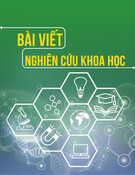
49
Sè §ÆC BIÖT / 2024
Summary
Purpose: This study utilizes a phenomenological framework, specifically Merleau-Ponty's body
phenomenology and lifeworld theory, to investigate the application of yoga practices learned in
physical education by university students during their "ME TIME" and its impact on their lived
experiences. Methods: Employing Interpretative Phenomenological Analysis (IPA), the study
scrutinized in-depth interviews alongside reflective diaries contributed by 15 university students.
Results: Noteworthy insights encompass: (1) Heightened consciousness of one's physical
existence; (2) Merging breath and motion into everyday practices; (3) Establishing personal limits
during introspection; (4) Utilization of awareness strategies; (5) Enhanced comprehension of tension
and coping methods; (6) Increased self-embrace and healthier exchanges with companions. The
findings indicate that the integration of yoga into "ME TIME" fosters a more holistic life experience
for students. Conclusion: This investigation reveals how pupils blend mind-body exercises into their
daily activities, contributing significant understanding for integrated development efforts in higher
education. Restrictions are linked to how well the sample can encapsulate the wider community
and any biases that might occur in self-description. Future research should broaden sample
diversity, employ mixed methodologies, undertake longitudinal studies, and investigate individual
differences in the effects of yoga practices.
Keywords: Yoga, Phenomenological analysis, Mind-body integration, Mindfulness.
(1)Assoc. Prof. PhD, Department of Sports, National Changhua University of Education, Taiwan
(2)Assoc. Prof. PhD, Department of Tourism and Leisure Management, Ling Tung University, Taiwan
(3)Assoc. Prof. PhD,Department of Adapted Physical Education, National Taiwan Sport University, Taiwan
Meng-Ling Chung(1); Wan-chun Hsiung(2); Cen-yi Lin(3)
INTRODUCTION
This study explores how university students
apply yoga learned in physical education courses
to their "ME TIME" and its impact on their lived
experiences, addressing the high prevalence of
mental health issues among students (Auerbach et
al., 2018; Eisenberg et al., 2022; Huang et al.,
2019). Yang (2023) indicated that effective use of
"ME TIME" correlates with higher life satisfaction
and lower stress levels. The investigation is
grounded in Merleau-Ponty's body
phenomenology and lifeworld theory. Merleau-
Ponty emphasizes the body as a fundamental aspect
of existence, with his concept of "body schema"
suggesting that bodily perception is an innate, non-
reflective capability. Lifeworld theory posits that
our primary relationship with the world is rooted
in pre-scientific and non-reflective experiences.
These frameworks provide a lens to examine how
students' bodily practices through yoga intersect
with their everyday experiences, mental well-
being, and self-perception. With a focus on
Interpretative Phenomenological Analysis (IPA),
this examination seeks to unveil the relationships
between bodily engagement, regular experiences,
and emotional health. It offers theoretical and
practical foundations for implementing mind-body
integration strategies in higher education, exploring
how students incorporate yoga into their personal
time and its effects on their lived experiences.
Based on the research objectives, here are six focus
group interview questions designed to address the
key points:
RESEARCH METHODS
This study employs Interpretative
Phenomenological Analysis (IPA) to explore
university students' yoga experiences during "ME
TIME". IPA was chosen for its ability to capture
nuanced personal experiences and meanings,
interpretable through Merleau-Ponty's body
phenomenology. Fifteen participants (8 females,
7 males, aged 19-23) were purposively sampled,
having attended university yoga courses and
consciously integrated yoga into daily life. Data
collection involved: (1) 60-90-minute in-depth
semi-structured interviews; (2) four-week
A PHENOMENOLOGICAL ANALYSIS OF UNIVERSITY STUDENTS'
APPLICATION OF PE-YOGA PRACTICES TO DAILY "ME TIME": AN
EXPLORATION OF MIND-BODY INTEGRATION IN THE LIFEWORLD

p-ISSN 1859-4417 e-ISSN 3030-4822
50
reflective journals. Data analysis followed IPA's
six steps, including repeated case reading, initial
noting, theme development, identifying inter-
theme connections, and cross-case analysis.
Researchers continuously reflected on biases and
assumptions, engaging peer researchers for
independent analysis to enhance credibility.
RESULTS AND DISCUSSION
1. Bodily Experiences of Physical
Education Yoga Practices
1.1. Augmented Bodily Awareness
P3 (female, 21) said: "Now, even while seated,
I'm aware of my body's condition." This
awareness helped address physical needs and
recognize emotions. P7 (male, 20) added:
"Focusing on physical sensations helps perceive
emotional changes." Findings show yoga as both
physical practice and life philosophy, embodying
Merleau-Ponty's body-consciousness unity.
Participants use somatic practices to influence
mental states and apply yoga principles daily,
aligning with Merleau-Ponty's view of the body
as primary means of engaging reality.
1.2. Convergence of Breath and Motion
Participants integrated breath-movement
beyond yoga into daily life, using conscious
breathing for relaxation. P5 (female, 22) said:
"Yoga taught me to regulate my state through
breathing. Before stressful situations, I adjust my
breath to calm quickly." P10 (male, 19) added: "I
observe my breath while walking or climbing
stairs, maintaining calm in busy campus life."
2. Yoga Application in "ME TIME"
2.1. Creating Personal Space and Time
Participants successfully created personal
space and time by integrating yoga into "ME
TIME". One participant (P2, female, 20)
described: "My 15-minute morning yoga practice
has become the most valuable 'ME TIME' of my
day. During this time, I feel completely isolated
from the outside world, able to truly dialogue
with myself." Another participant (P12, male, 21)
shared how he created personal space in a
crowded dormitory: "Even in a four-person dorm,
I've learned to use the small space beside my bed
for simple yoga poses and meditation. This helps
me find inner peace in a noisy environment."
2.2. Mindfulness Practice in Daily Life
Participants applied yoga mindfulness to
daily life. P8 (female, 23) said: "I practice
mindfulness while eating, savoring each bite.
This enhances enjoyment and promotes
healthier habits." "ME TIME" proved crucial for
integrating yoga into daily life, providing space
for self-reflection and mind-body regulation.
Phenomenologically, it represents a unique lived
experience of focused existence, free from
external distractions.
3. Transformation of the Lived World
through Mind-Body Integration
Table 1. Focus group questions
1. Can you describe your experiences with mind-body integration practices in your yoga
courses? How do you understand the connection between physical postures and mental states
in yoga?
2. How have you incorporated yoga practices into your daily "ME TIME"? Please share spe-
cific examples of how you've adapted yoga techniques for use outside of class.
3. What challenges have you faced when trying to integrate yoga into your daily routine? Con-
versely, what opportunities or benefits have you discovered through this process?
4. In what ways has practicing yoga during your "ME TIME" changed how you perceive your-
self? Have you noticed any differences in how you view your body, emotions, or thoughts?
5. Has your yoga practice influenced how you interact with others or perceive your environ-
ment? If so, can you provide examples of these changes?
6. How has integrating yoga into your daily life affected your approach to managing stress and
daily challenges? Can you share a specific instance where you applied yoga techniques to cope
with a stressful situation?

51
Sè §ÆC BIÖT / 2024
3.1. Changes in Stress Perception and Coping
Participants reported significant changes in
their perception and coping with stress. One
participant (P6, female, 21) shared: "Before, I
always felt anxious and helpless when facing
stress. Now, I've learned to regulate my
emotions with yoga breathing. This not only
helps me face stress more calmly but also allows
me to learn and grow from it."
3.2. Reshaping Relationships with Self and
Others
Participants reported increased self-
acceptance and empathy. P4 (female, 19) said:
"Yoga helped me accept imperfections. I no
longer demand perfection, but appreciate
progress and growth. This self-acceptance makes
it easier to understand and accept others."
Through yoga integration, participants
experienced significant transformation in their
lived world. From feeling disconnected and
stressed, they achieved a more integrated lifestyle
through consistent practice, especially during
"ME TIME". This shift aligns with Merleau-
Ponty's lifeworld theory, as participants
reconstructed their world through bodily practice,
enhancing self-awareness, emotional regulation,
empathy, and interpersonal relationships.
4. Challenges and Adaptations
4.1. Continuity and Consistency of Practice
Maintaining consistent practice was a
significant challenge. One participant (P13,
male, 20) admitted: "Maintaining daily practice
is the biggest challenge. Sometimes I skip yoga
time due to assignments or social activities. I'm
trying to view yoga as an indispensable part of
life, not an optional extra activity."
4.2. Overcoming Initial Resistance and
Discomfort
P1 (female, 22) shared: "Initially, morning
yoga made me feel stiff and unfocused. I wanted
to quit but persisted. Gradually, discomfort turned
to comfort and pleasure. " Merleau-Ponty's
theory reveals students reconstructing their
lifeworld through yoga. Consistency challenges
show "habit body" formation; yoga's importance
indicates efforts to reshape world relationships.
The comfort transition reflects body schema
reconstruction, demonstrating bodily subjectivity.
This highlights yoga's potential in reshaping
students' existence and world understanding.
CONCLUSION
This study used a phenomenological approach
to examine how university students apply yoga
learned in physical education to their daily "ME
TIME" and its impact on their lived experiences.
Findings show that integrating yoga into daily life
enhanced bodily awareness, breath-movement
integration, personal space creation, mindfulness
cultivation, stress perception changes, and
relationship reshaping. This reveals yoga's
potential in reconstructing students' lifeworlds,
leading to a more integrated lifestyle. Challenges
like maintaining consistency and overcoming
initial discomfort were noted. The investigation
highlights ways in which higher education can
better weave yoga into the daily lives of students
and indicates potential subjects for future
exploration regarding yoga's enduring influence
on student wellness.
REFERENCES
1. Auerbach, R. P., Mortier, P., Bruffaerts, R.,
Alonso, J., Benjet, C., Cuijpers, P., Demyttenaere,
K., Ebert, D. D., Green, J. G., Hasking, P.,
Murray, E., Nock, M. K., Pinder-Amaker, S.,
Sampson, N. A., Stein, D. J., Vilagut, G.,
Zaslavsky, A. M., & Kessler, R. C. (2018). WHO
World Mental Health Surveys International
College Student Project: Prevalence and
distribution of mental disorders. Journal of
Abnormal Psychology, 127(7), 623-638.
2. Eisenberg, D., Ketchen Lipson, S., Ceglarek,
P., Phillips, M., Zhou, S., Morigney, J., Talaski, A.,
& Steverson, S. (2022). The Healthy Minds Study:
National trends in mental health outcomes among
U.S. college students, 2013-2021. Journal of
Affective Disorders, 306, 135-142.
3. Huang, J. T., Wu, Y. C., & Liu, Y. C.
(2019). Prevalence and predictors of depression,
anxiety, and stress among university students in
Taiwan. Journal of Educational and
Developmental Psychology, 9(2), 34-46.
4. Yang, C. C. (2023). The role of "ME
TIME" in college students' well-being: A
mixed-methods study on time use, life
satisfaction, and stress management. Journal of
College Student Development, 64(2), 180-196.
(Received 4/9/2024, Reviewed 13/11/2024, Accepted 28/11/2024
Main responsible: Meng-Ling Chung; Email: cmleva6311000@gmail.com)


![Đề cương ôn tập Bản đồ du lịch [năm hiện tại]](https://cdn.tailieu.vn/images/document/thumbnail/2025/20250809/dlam2820@gmail.com/135x160/53061754884441.jpg)























